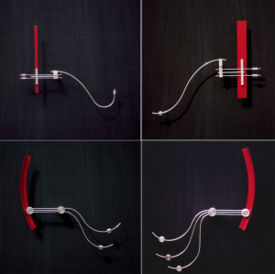Royal Miree
Royal Miree is an artist, specializing in kinetic sculpture.
Miree is the son of a general contractor, and spent much of his childhood walking construction sites or with my mother at the Birmingham Zoo, never missing a National Geographic, Nova, or Wild Kingdom special on television. He also enjoyed building and taking things apart to find out how they worked.
At fifteen he began an apprenticeship to kinetic sculptor Edward Hendricks and found an entirely different side of art not bounded by the margins of a static canvas, but an art that utilizes every piece of itself to be realized.
At 19, Miree left Birmingham to study architecture, and began working in a studio in New York, exploring different media and subjects. Studies of form and movement progressed through toward minimalism of expression and economy of means. His maturing work aimed to create a fluid, figurative image using the minimal amount of material -- softening hard materials through graceful movements, always refining the visual affect the work creates while in motion.
Creation of a kinetic sculpture
- A design is transferred to actual size on a board with concentric circles designating rotation of the various elements.
- Raw metal stock is cut, measured, weighed and milled for the anchor components.
- A large stack of discs with different radii is used to form and bend the curves and counter curves of the tail pieces.
- All pieces are assembled and fixed into an axle and ball-bearing housing, which will be mounted to the wall.
- At this stage distances and weights from the rotation point are analyzed and calculated using various counterweights to achieve a smooth rotation and match to an exact position of horizontal balance when the assembly comes to it's resting position.
- The entire rough assembly design is then transferred back to the board with all weights, sizes and distances noted and is then disassembled for polishing or painting.
- To achieve the mirror polish, each component is run through five sanding stages starting with a 180 grit sandpaper to remove tooling and milling marks and ending with a 600 fine grit surface. At this stage the aluminum components are complete.
- The stainless steel components are put through a three-stage rotary buffing process to bring each piece to a final mirror finish.
- After each component is cleaned and waxed, the entire work is re-assembled and mounted back to the wall so that the final balance and adjustments can be made.
Awards and recognitions
- Best in Show, Tannery Row Festival of the Arts
- Best in Show (3 dimensional), Dragon-Con Artist Market
- Best in Show (3 dimensional), Eastern Shore Chamber Festival of the Arts
- Featured artist for Art & Wine magazine, cover issue 2003
- Featured artist for Yoga magazine, cover issue 2004
- Featured artist for Southern Living magazine, January 2004
- Featured in Black & White magazine, 2000, 2001, 2003, 2006
- Featured in Birmingham Weekly, 2000, 2001, 2003
- Featured in Birmingham News, 2000,2003,2005,2006
Selected exhibitions
water color, conté and charcoal
- Arceneaux Gallery, 1996-1997
- Clary Sage Gallery, 1995-1996
- Magic City Art Connection, 1996-2006
- Wanda June's, 1998-2002
- Mauby's, 1998-2000
- Bradshaw House Gallery, 1999-2002
- Anthony's, 1999-2005
- Decorator's Show House, 2000-2006
- Highland Bank, 2000-2001
- Bottega, 2001
- Kentuck Festival of the Arts, 1996
- Bare Hands Gallery, 2001
- Naked Art, 2000-2002
- Park Lane Restaurant, 2003-2006
- Ciao, 2004-2006
- Daniel George
kinetic sculpture
- Gallery Services, 2006
- 26, 2006
- Magic City Art Connection, 2000-2006
- DragonCon, 2001-2005
- Bluff Park Art Show, 2006
- Art Walk, 2006
- and numerous art festivals around the South
External links
- Royal Miree sculptures at richardmiree.com
